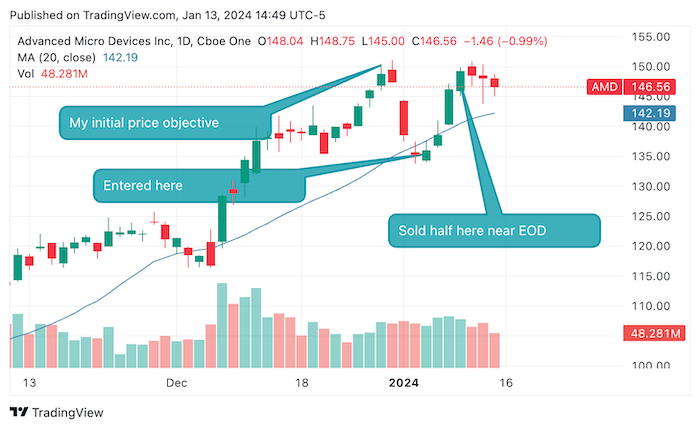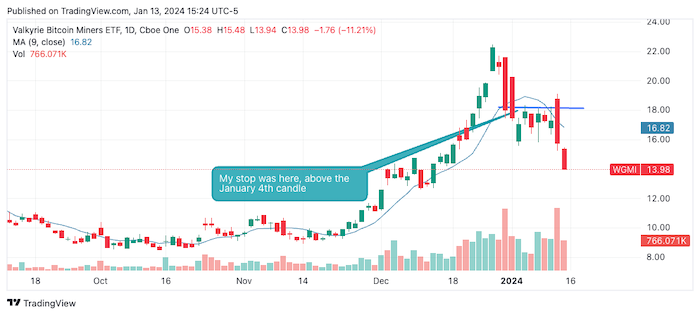Trades of the Week: Jan 8 - Jan 12, 2024
January 13, 2024
I came into this week short WGMI and long QS, TEAM, AMD, DYN and TANK. Those essentially used up all my non-margin buying power. As I mentioned in a position sizing discussion on the Canadian version of SwingTradeBot, I don't like to be on margin overnight. But after initiating a few of more trades early in the week I soon found myself needing to lighten up -- late Tuesday my brokerage pinged me that I had exceeded my overnight buying power (a Regulation T violation). So I had to choose some stocks to sell or the brokerage would have done it for me.
My account at that point was up 9.6% YTD with the majority of that being unrealized gains. So I was happy to take some profits off the table & decided to sell half of several of my positions.
AMD & TEAM followed through nicely from last week. Somehow they're both trading in lockstep -- they had very similar setups (pulled back below their 20 DMAs and then reclaimed that MA) and have both risen back to their highs from before their dips. Here's the AMD chart:
My account at that point was up 9.6% YTD with the majority of that being unrealized gains. So I was happy to take some profits off the table & decided to sell half of several of my positions.
AMD & TEAM followed through nicely from last week. Somehow they're both trading in lockstep -- they had very similar setups (pulled back below their 20 DMAs and then reclaimed that MA) and have both risen back to their highs from before their dips. Here's the AMD chart:

One nice thing about both of these setups is that they presented really tight stops on high priced stocks. Given my position sizing methodology (Percent Risk model) that provides me the opportunity to put a lot of money to work while still only risking my usual 1% of my equity -- the tighter the stop, the more shares I can buy. In the case of AMD, I entered above the January 4th candle (and 20 DMA) at $138.34 with a stop just under that candle at $133.75. So my initial risk (1R) was $4.59 (AMD's Average True Range is 4.90 -- a ~1 ATR stop is about the tightest I'll ever use). I sold half of my shares at $149.21 -- so that's a 7.85% ($10.87) move for AMD and a profit for me of 2.36 times my initial risk (2.36R). It pulled back a bit since my sale and I'm currently sitting on a 5.94% gain on the other half of the shares.
TEAM is very similar and I'm currently holding on a 5.22% gain on my remaining shares.
WGMI another carryover from last week was the most frustrating trade of the week! Like I mentioned last week, I was using WGMI as a way to play the unwinding of the parabolic move the Bitcoin miners had. I nailed a short in MARA in the last week of December and I thought I'd press my luck and go back to the well on what I thought was a dead cat bounce. WGMI dropped 17% on the week but unfortunately it took a wild path to get there and shook me out. I got tired of the chop on the 10th and closed the trade for a 0.22R loss. Thankfully I did so then because it gapped up the next morning on news of the Bitcoin ETF approval. That gap would have stopped me out for about a 1.3R loss. But the frustrating part is that the miners finally broke after the gap up -- a classic sell the news reaction.

I saw the gap up when the market opened but I had to leave to go to a doctor's appointment. So I didn't see the action until the big slide had already happened. In hindsight, I should have put in a short sale order below the previous day's candle because I suspected we might get a "gap & crap". Oh well! I hate when things like this happen -- I have the right idea but the price action just doesn't cooperate. But I do take solace in the fact that I was in the right place and on the right (short) side.
I took a few other trades during the week with mixed results on a whole:
I took a few other trades during the week with mixed results on a whole:
- I bought GFS on the 8th after it made a Non-ADX Pullback but ended up selling that outright for a small gain when I got that Reg T warning (0.24R gain)
- I also bought NET on the 8th on a Non-ADX Pullback. Took a partial on the 9th and my trailing stop got hit on the other half on the 11th. (1R gain)
- Bought OMGA on the 10th after it made a Calm After Storm. It was working nicely on day 1 but reversed hard on day 2. I decided I didn't like that action and took a 0.8R loss
- Bought TOST on the 10th. This was one of the "Intraday Runners" I wrote about in my 2023 recap. It had a pretty big gap up thanks to an upgrade. When I saw it close the gap and start bouncing I took a bet on it reclaiming the highs of the day. It failed to do so! (1R loss)
- I also closed out TNK. This was another one where I sold half on Tuesday. It kept trying to roll over mid-week and I finally thought the whole "buy the shippers because of Middle East strife" trade had gotten long in the tooth, so I exited on Thursday. (1.2R gain)
It ended up being a "meh" week. I was up a quick 5% for the week by Tuesday but after pullbacks, especially an intraday swoon on Thursday, I ended the week only up 1.2% and 5.39% YTD.
PS: There may not be another of these posts until the first week of February because I'll be on vacation in Australia. I'm not sure if I'll be doing much trading although I do already have some orders in for Tuesday.
Comments
D
Deaddog 10 months ago
Can you explain how you use the initial target?
I take it that there is no set rule, the decision is made depending on the price action.
What is your process? What are the if/then scenarios that go thru your mind as price hits your initial target?
What time frame are you using to make decisions?
I take it that there is no set rule, the decision is made depending on the price action.
What is your process? What are the if/then scenarios that go thru your mind as price hits your initial target?
What time frame are you using to make decisions?
T
TraderMike 10 months ago
I mostly use the initial target as a way to figure out if it's a good reward:risk setup. In the case of AMD, I thought it could at least get back to the old high which would mean the reward:risk ratio was ~2.5, IIRC. If I see a less R:R of less that 2 I'm probably not going to take the trade.
Like I said before about exits, they're more art than science for me. My thinking could vary based on a lot of things. If the broad market is extended or stalling I might be quicker to take profits. If the stock itself is stalling I'll probably take a partial profit if the stock is up at least 2R.
My general plan of action is:
Like I said before about exits, they're more art than science for me. My thinking could vary based on a lot of things. If the broad market is extended or stalling I might be quicker to take profits. If the stock itself is stalling I'll probably take a partial profit if the stock is up at least 2R.
My general plan of action is:
- Move my stop to break-even once I get 1R of profit.
- At 2R start to think about trailing the stop, especially if that 2R came quickly
- At 3R or more I'm probably pretty seriously thinking about selling half and having a somewhat loose trailing stop on the other half of the shares. But how loose/tight would depend on how much I believed in the move.
I'm not sure what you're asking with regard to the timeframe. If you're asking how long I'd hold a positions ideally I'd hold that half position for months if the price action let me. But if the stock starts going sideways and I see other potential fresh setups I'd probably bail on the stalled one and put the money in the more promising setup.
D
Deaddog 10 months ago
By time frame I'm wondering if you are monitoring these trades in real time, checking your positions as the trade unfolds or whether you check the positions at regular intervals during the day, like every couple of hours.
My set-up time frame is the daily chart. I'll check the 5 minute chart to see how the price is moving before I place an order.
I swing trade so that I don't have to spend my day in front of a monitor, I spend most of my time after the market closes looking for set-ups and a hour or less in the morning entering trades. I might check once or twice a day though most of my orders are set it and forget it.
My set-up time frame is the daily chart. I'll check the 5 minute chart to see how the price is moving before I place an order.
I swing trade so that I don't have to spend my day in front of a monitor, I spend most of my time after the market closes looking for set-ups and a hour or less in the morning entering trades. I might check once or twice a day though most of my orders are set it and forget it.
T
TraderMike 10 months ago
I'm usually monitoring the market in the mornings. I scan at night & get my orders in before the market opens the next day. But if I happen to see something developing in the first couple of hours of the day I'll make some moves. Normally I'm off to other things by lunch time but I certainly do check in on my broker's mobile app during the afternoon.
This old blog post has more insight into my daily process - How and Why I'm Using the New Intraday Alerts... it hasn't changed much.
This old blog post has more insight into my daily process - How and Why I'm Using the New Intraday Alerts... it hasn't changed much.
D
T
TraderMike 10 months ago
I needed to get off of margin due to the Reg T violation. Even without the official voilation, like I mentioned in that other thread, I don't like to be on margin overnight. i had way too much exposure and needed to dial things back. AMD was at my initial target and had gotten there with a quickness, so IMHO it was ripe for at least a partial sale.
View full discussion...
Popular Now
Recent Comments
- TraderMike on Canadian Depositary Receipts
- Cos3 on Canadian Depositary Receipts
- TraderMike on Canadian Depositary Receipts
- TraderMike on Canadian Depositary Receipts
- Cos3 on Canadian Depositary Receipts
From the Blog
Featured Articles